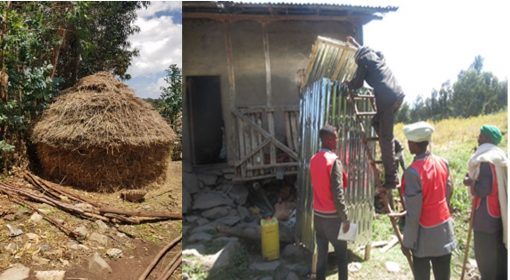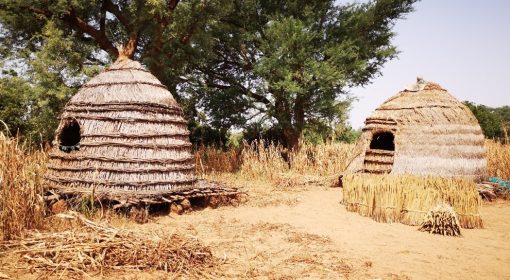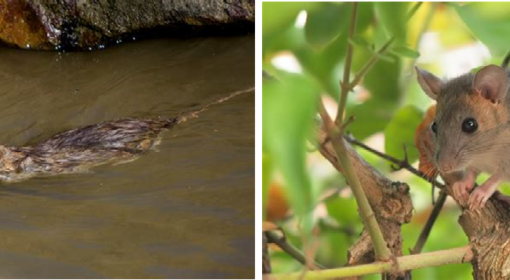Authors: Luwieke Bosma, Lucia Moreno Spiegelberg and Gauthier Dobigny.
Pour la version en français, cliquez ici.
Good day! My name is Rova and I live in Ankasina, a neighbourhood of Antananarivo, the capital city of our beautiful island Madagascar! I guess you would describe our neighbourhood as a slum, but we call it here “bas-quartier”, meaning the “lowland district. This name has a history: in the past, the kings and queens, their court and the rich and powerful people lived in the higher parts of the land. While poor workers were cultivating rice in these floodable, lower parts of the country to feed them. Today, most of poor areas of Antananarivo lie within these lowlands that still get flooded nowadays, as you can see in the pictures. Many of the “bas-quartiers” consist of informal and very vulnerable settlements, mostly inhabited by poor families which usually have very limited access to jobs, education or health. They are highly insalubrious.
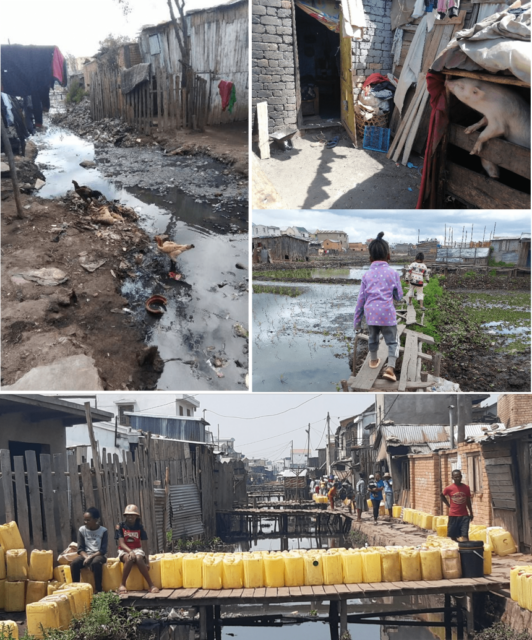
Figure 1 These photos show the poverty levels and unsanitary environment of Ankasina in Antananarivo, Madagascar. Water supply is also a major problem, as shown by the long line of jerry cans waiting to be filled with drinking water at the public fountain.
As you can see our living conditions are not easy: sanitation is absent, access to safe water is difficult, ways are very unstable, and garbage is omnipresent. Rodents are abundant all around the place. The Malagasy highlands are beautiful and host a large variety of very unique species, such as the famous lemurs. Unfortunately it is also an endemic region for human plague, a disease best known for its large outbreak in the 14th century, also named the “Black Death” which killed almost half of European inhabitants.
Around ten years ago, the capital city Antananarivo was hit hard by a plague outbreak. More recently, researchers visited us, seeking help to tackle the rodent problem. They pointed out that, aside from the well-known plague, there are other diseases such as typhus and leptospirosis that are often ignored.[i] They told us that in our community, rats are more likely to spread these lesser-known diseases than the plague, putting us at an even greater risk. But how do we know if it’s these diseases that is causing our fevers?
I told the researchers I was interested to work with them and learn more about this topic, together with two other guys from the neighbourhood, Diallo and Bolida, we became a strong team. I can say that we are now the bridge between the researchers and the community, we learn a lot about rodents, their fleas, the way they live, the microbes they carry, and we translate this to the inhabitants. We do a lot of different things, such as trapping the rodents and collecting the fleas with the researchers, and conducting surveys to known what people think about rodents and the problems they pose. We also participate in educational and awareness campaigns, in partnership with a local NGO, Vahatra. Recently, we spent a morning engaging with the community through music and discussions about rodent control, with activities for kids, including dances and songs about rodents. This hands-on approach has helped raise awareness in a way that’s engaging and informative.
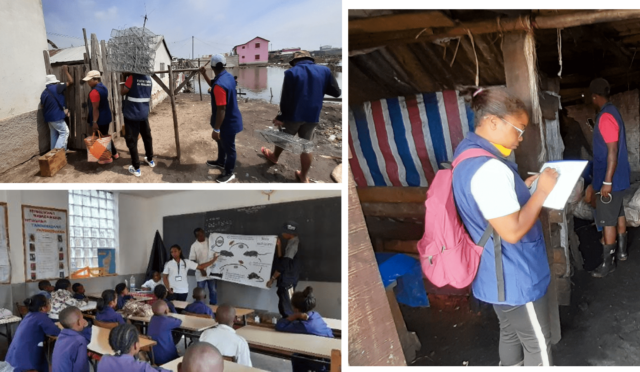 Figure 2 Examples of the work Rova, Diallo and Bolida do in Ankasina. The picture at the bottom left shows Zaina (IPM) teaching schoolkids about rodent-vectored diseases.
Figure 2 Examples of the work Rova, Diallo and Bolida do in Ankasina. The picture at the bottom left shows Zaina (IPM) teaching schoolkids about rodent-vectored diseases.
I want to introduce you to Nirina, who was also there. She is one of the researchers at the Institute Pasteur in Madagascar who leads the project in Madagascar. She explains: the collaboration with the community is essential for us as researchers, it is a real exchange and we learn a lot about rodents from the people. We organize the fieldwork with our team at community level Rova, Diallo and Bolida, we guide them on how to set the traps, do the surveys, etc. Then when we have results, we organize a community meeting to explain them, and to get their feedbacks and their ideas. We discuss with them on the next steps: what could we do in Ankasina to decrease the rodents’ nuisances? For instance, the next plan is to start with a test on participatory trapping, before starting this we will call the community to see if they consent to such. At this moment we also look back and see we have been making steps, people in Ankasina now acknowledge rodents are an issue, this may sound little, but we can’t underestimate the importance of this for the next achievements.
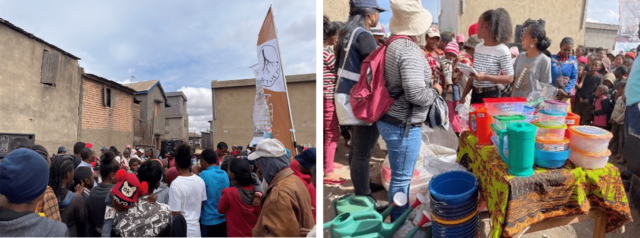
Figure 3 Community awareness campaigns with music, dance and demonstration of good practices
Rodents are a notorious hazard to human health, but the risk and severity imposed by rodents is multi-faceted. People who live in degraded environments, like a slum, are more exposed to rodents and rodent-borne zoonoses, especially those that are not in good health, or children are susceptible. Furthermore, rodents are known to adapt very well to human lifestyle, but also are in a way unpredictable in their movement patterns, this can depend upon many things such as harvesting seasons and climatic factors. In the developing world, poverty-stricken individuals bear a heavy load of neglected communicable diseases, often overlooked by the health sector. These diseases earn their “neglected” label due to their impact primarily on impoverished populations, lack of compulsory reporting in many countries, and minimal recognition compared to major diseases like HIV/AIDS, tuberculosis, and malaria. Their absence from epidemiologic emergencies diminishes media and public sector attention, while their limited profitability deters interest from the private sector. Nevertheless, neglected diseases take heavy social and financial tolls on individuals, families, communities, and nations.[i] While there is another issue here, the symptoms of many different diseases are not very specific, you can’t easily tell the difference between symptoms of malaria and leptospirosis. So in a case where health officers are not well-trained, it results to them being neglected as people don’t know how to recognize them.
What is important to know about rodents when you want to fight in such an urban landscape? Well a few things, and first of, movement. Specifically knowing how far rodents may move within the urban landscape. This is very important for rodent management because it gives us concrete elements about the spatial scale at which rodent control should be implemented. Especially in a highly populated urban context, this comes very specific, and will teach us a lot about the approach in terms of community involvement.
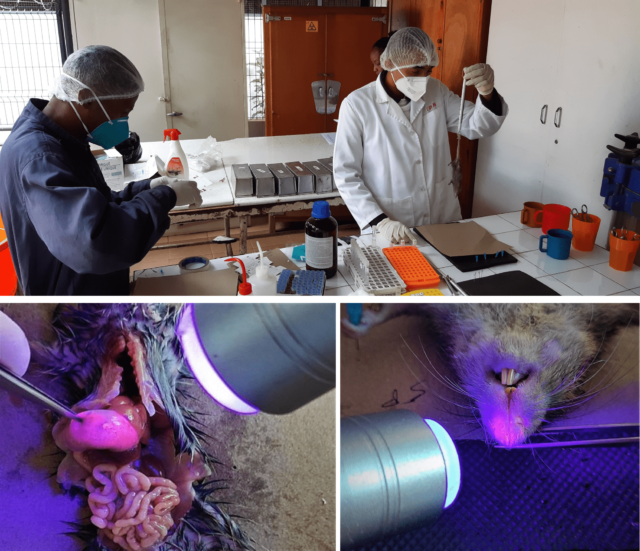
Figure 4 Lab work by student Tahiana who started the work with rhodamine, the pictures below show the UV lamp clearly highlighting rhodamine traces
This was the first time we had studied this aspect in an African city. Our student Tahiana placed baits containing rhodamine (a dye that can be detected in ultraviolet light) in the field at precise geo-referenced locations. The rodents were then captured and those that had smelled or eaten the rhodamine-labelled bait were identified in the laboratory using a simple UV lamp shone on their nose or organs during dissection. Positive animals, i.e. with fluorescent noses or stomachs, clearly indicated that they had been in contact with the bait, usually within the last 24 to 48 hours.
In Antananarivo, our observations were rather intriguing: contrary to what has previously been described in other cities around the world, rats in the Malagasy capital appear to be particularly mobile, regularly travelling several hundred metres in the same night. What’s more, they frequently move between the rice paddies in the shallows and the houses in the surrounding area. Tarmac roads do not seem to be an obstacle to their movements. Finally, the markets (and probably the goods they contain) seem to attract them from more than 100 metres away.
In addition to the mobility of the rats, we also discovered that mice were very abundant in the city’s houses, and that they reproduced all year round. Their incredible capacity to proliferate is not good news, because it means that we will also have to take action against this small, hard-to-grasp species, and that we will have to do so continuously to limit their abundance.
We are continuing to make progress on evaluating and adapting rodent control strategies at Ankasina. With our entire team in the field, we are continually planning new stages in our research, which is evolving as we gather information and obtain results. We feel that we now have a solid base in the neighbourhood and have clearly succeeded in breaking the ice on the subject, for example by raising awareness of rodent problems during our numerous research and education sessions in the field. Having gained a better understanding of the diversity and ecology of rodents in Ankasina, we now plan to offer residents a participatory approach to rodent control, in which Rova, Diallo and Bolida will distribute traps to residents, who will then collect the captured rodents each morning. These mass captures will be combined with the use of tracer plates: these are paint-coated tiles that show whether rodents have passed through. In our case, they will be used to assess the effect of these traps on rodent activity, and thus to check that participatory pest management is effective. We still have a long way to go, but every step of the way we learn something new!
In SCARIA we work towards sustainable community-based mitigation of rodent issues in the African cities of: Niamey in Niger, Cotonou in Benin, Wolaita Sodo in Ethiopia and Antananarivo in Madagascar. In Antananarivo we work in the neighbourhood of Ankasina, which is a slum typical for urban plague emergence risk.

Suggestions for further reading :
Awoniyi, A.M., Barreto, A.M., Argibay, H.D. et al. Systematic surveillance tools to reduce rodent pests in disadvantaged urban areas can empower communities and improve public health. Sci Rep 14, 4503 (2024). https://doi.org/10.1038/s41598-024-55203-5
Awoniyi, A.M., Venegas-Vargas, C., Souza, F.N. et al. Population dynamics of synanthropic rodents after a chemical and infrastructural intervention in an urban low-income community. Sci Rep 12, 10109 (2022). https://doi.org/10.1038/s41598-022-14474-6
Awoniyi, A. M., Souza, F. N., Zeppelini, C. G., Xavier, B. I. A., Barreto, A. M., Santiago, D. C. C., Santana, J. O., da Silva, E. M., Costa, F., Begon, M., & Khalil, H. (2021). Using Rhodamine B to assess the movement of small mammals in an urban slum. Methods in Ecology and Evolution, 12, 2234–2242. https://doi.org/10.1111/2041-210X.13693
Learn more about neglected diseases in this “Global report on neglected tropical diseases 2024. Geneva: World Health Organization; 2024. Licence: CC BY-NC-SA 3.0 IGO. https://www.who.int/teams/control-of-neglected-tropical-diseases/global-report-on-neglected-tropical-diseases-2024
Ehrenberg, J.P., Ault, S.K. Neglected diseases of neglected populations: Thinking to reshape the determinants of health in Latin America and the Caribbean. BMC Public Health 5, 119 (2005). https://doi.org/10.1186/1471-2458-5-119
